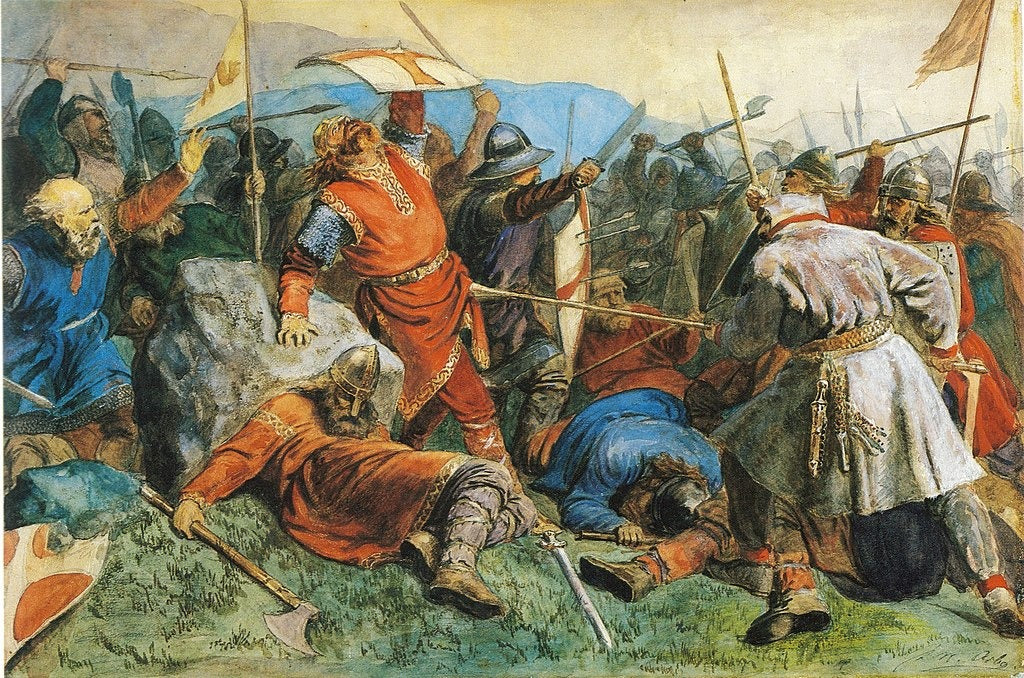
The Raid on Lindisfarne (793 AD): A Turning Point in Medieval History
The mist hung low over the churning sea, concealing the approach of doom. On that fateful morning in 793 AD, the monks of Lindisfarne could not have imagined the horror that awaited them—or the seismic shift in history their tiny island was about to witness.
The Peaceful Island of Lindisfarne
Nestled off the northeastern coast of England, Lindisfarne—also known as Holy Island—was a haven of tranquility and spiritual devotion. Its isolation and unique tidal patterns, which cut it off from the mainland twice daily, made it an ideal location for those seeking solitude and communion with the divine.

Monastic Life on the Holy Island
The monastery of Lindisfarne, founded in the 7th century by the Irish monk Saint Aidan, had flourished into a center of learning and artistic achievement. Here, amid the windswept dunes and rocky shores, monks labored tirelessly to create illuminated manuscripts of breathtaking beauty. The Lindisfarne Gospels, a masterpiece of medieval art, stood as testament to their skill and devotion.
Lindisfarne's Strategic Location
Yet, the very isolation that made Lindisfarne attractive to the monastic community also rendered it vulnerable. Situated at the crossroads of important sea routes, the island was unwittingly positioned as a tempting target for seafaring raiders seeking riches and glory.
The Fateful Day: June 8, 793 AD
As dawn broke on that fateful summer morning, none on Lindisfarne could have foreseen the terror that approached their shores. The day began like any other, with the rhythmic chants of morning prayers echoing across the island.

The Approach of the Viking Longships
From the mist-shrouded sea, sleek wooden ships with dragon-headed prows emerged—harbingers of doom gliding silently towards the unsuspecting community. The Vikings, those fierce warriors from the north, had arrived on English soil.
The Shock of the Unexpected Attack
The first sign of danger came with the war cries that shattered the morning calm. Monks, caught unawares in the midst of their devotions, found themselves face to face with axe-wielding marauders. The peaceful world of Lindisfarne erupted into chaos as the raiders swarmed ashore, their eyes gleaming with the prospect of plunder.
The Vikings: Ruthless Raiders from the North
To understand the impact of the Lindisfarne raid, one must first grasp the nature of its perpetrators. The Vikings were not merely pirates or bandits; they were the product of a complex Norse society driven by both internal pressures and external opportunities.

Origins and Motivations of the Norse Warriors
Hailing from the fjords and forests of Scandinavia, the Vikings were a people shaped by harsh landscapes and even harsher winters. Their society valued strength, courage, and the accumulation of wealth as means of securing one's place in the afterlife. The raid on Lindisfarne was not just a quest for riches, but a chance for young warriors to prove their mettle and win fame among their peers.
Viking Tactics and Weaponry
The success of the Lindisfarne raid owed much to the Vikings' superior naval technology and combat tactics. Their longships, marvels of engineering, allowed them to navigate both open seas and shallow rivers with equal ease. Armed with axes, swords, and shields, the Norse warriors were a formidable fighting force, their ferocity amplified by the element of surprise.
The Aftermath of the Raid
As swiftly as they had come, the Vikings departed, leaving behind a scene of devastation that would scar the collective psyche of Anglo-Saxon England for generations.

The eroded walls of the Lindisfarne Monastery / Photo: Rodtuk, CC BY-NC-SA 2.0
Immediate Consequences for Lindisfarne
The monastery lay in ruins, its treasures looted, its sacred texts desecrated. Many monks were slain, while others were taken as slaves—a fate perhaps worse than death. The surviving community was left to grapple with the enormity of their loss and the shattering of their perceived divine protection.
Ripple Effects Across Anglo-Saxon England
News of the raid spread like wildfire across the kingdoms of England. The attack on Lindisfarne was not merely a localized tragedy; it was a wake-up call that exposed the vulnerability of coastal communities throughout the British Isles. Kings and nobles scrambled to bolster their defenses, but the seed of fear had been planted.
The Cultural Impact of the Lindisfarne Raid
The violence visited upon Lindisfarne reverberated far beyond the physical destruction it wrought. It marked a profound shift in the cultural and religious landscape of medieval Europe.

The 'Viking Domesday Stone' on display. This 9th-century grave marker, discovered at the Holy Island, features intricate carvings of seven armed warriors. Visitors can view this remarkable piece of Norse-era art at Lindisfarne's museum, offering insights into the island's rich heritage.
Religious Interpretations and Divine Punishment
For many contemporary chroniclers, the raid on Lindisfarne was nothing short of a divine judgment. The Anglo-Saxon monk Alcuin, in a letter penned shortly after the attack, lamented: "Never before has such terror appeared in Britain as we have now suffered from a pagan race. . . The church of St. Cuthbert is spattered with the blood of the priests of God, despoiled of all its ornaments."
The Birth of the "Viking Age" in Popular Imagination
While the term "Viking Age" is a modern construct, the raid on Lindisfarne undoubtedly marks its inception in the popular imagination. The image of fierce Norse warriors storming out from their longships with their bloodthirsty demeanour, began to take shape in the collective consciousness of medieval Europe.
Legacy and Historical Significance
The ripples from the stones cast into the waters off Lindisfarne continue to shape our understanding of medieval history and the complex interplay of cultures that forged modern Europe.
Lindisfarne's Place in the Narrative of European History
The raid on Lindisfarne serves as a powerful symbol of the clash between the Christian world of medieval Europe and the pagan Norse culture. It marks the beginning of a period of intense cultural exchange, conflict, and eventual assimilation that would transform the social and political landscape of Britain and beyond.
Archaeological Discoveries and Ongoing Research
In recent years, archaeological excavations on Lindisfarne and elsewhere have shed new light on the events of 793 AD and their aftermath. Discoveries of Viking artifacts alongside Anglo-Saxon treasures paint a more nuanced picture of the interactions between these two cultures, reminding us that history is rarely as black and white as it first appears.
Conclusion: Echoes of Lindisfarne in the Modern World
As we reflect on the raid on Lindisfarne more than twelve centuries later, we are reminded of the enduring impact of moments of cultural collision. The echoes of that fateful day in 793 AD continue to resonate in our modern world, where clashes of civilizations and the movements of peoples across borders still shape the course of history.
The story of Lindisfarne serves as a poignant reminder of the fragility of peace and the unpredictable nature of historical change. It challenges us to look beyond simplistic narratives of good and evil, inviting us to explore the complex tapestry of human motivations and cultural interactions that drive the engine of history.
In the end, the raid on Lindisfarne stands not just as a tale of violence and loss, but as a testament to the resilience of human spirit and the enduring power of cultural memory. From the ashes of destruction arose new forms of art, literature, and social organization that would help shape the world we inhabit today.
As we stand on the shores of our own uncertain present, gazing out at the horizon of the future, we would do well to remember the lessons of Lindisfarne. For in understanding our past, we gain invaluable insights into navigating the challenges that lie ahead.
FAQs
- What was the significance of Lindisfarne before the Viking raid?
Lindisfarne was a major center of Christianity in Anglo-Saxon England, famous for its monastery and the production of illuminated manuscripts like the Lindisfarne Gospels.
- How did the raid on Lindisfarne change Viking-Anglo-Saxon relations?
The raid marked the beginning of sustained Viking incursions into England, leading to centuries of conflict, cultural exchange, and eventually, Norse settlement in parts of Britain.
- Were there any survivors of the Lindisfarne raid?
While many monks were killed or taken as slaves, some did survive to recount the attack. The exact number of survivors is unknown.
- How did the English kingdoms respond to the threat of Viking raids after Lindisfarne?
English rulers began to strengthen coastal defenses, organize better response systems, and in some cases, pay tribute (Danegeld) to Viking leaders to prevent attacks.
- Is Lindisfarne still a religious site today?
Yes, Lindisfarne remains an important Christian pilgrimage site, with a medieval priory (built after the Viking age) and a modern retreat center attracting visitors from around the world.
References
Brown, M. P. (2003). The Lindisfarne Gospels: Society, Spirituality and the Scribe. University of Toronto Press.
Richards, J. D. (2005). The Vikings: A Very Short Introduction. Oxford University Press.
Blair, J. (2005). The Church in Anglo-Saxon Society. Oxford University Press.
Cavill, P. (2001). Vikings: Fear and Faith in Anglo-Saxon England. HarperCollins.
Forte, A., Oram, R., & Pedersen, F. (2005). Viking Empires. Cambridge University Press.
"The Keep at Lindisfarne" by SafarFiertze is licensed under CC BY-NC-SA 2.0.
"Images in stone - Lindisfarne Priory Museum" by Wendy North is licensed under CC BY-NC-ND 2.0.
"20170708-IMG_3126 Eroded Stone Monastry Monastry Lindisfarne Holy Island Northumberland" by rodtuk is licensed under CC BY-NC-SA 2.0.








